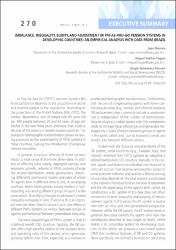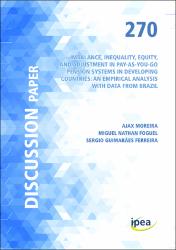Please use this identifier to cite or link to this item:
https://repositorio.ipea.gov.br/handle/11058/11383Full metadata record
| DC Field | Value | Language |
|---|---|---|
| dc.contributor.author | Moreira, Ajax Reynaldo Bello | - |
| dc.contributor.author | Foguel, Miguel Nathan | - |
| dc.contributor.author | Ferreira, Sergio Guimarães | - |
| dc.date.accessioned | 2022-08-17T17:42:33Z | - |
| dc.date.available | 2022-08-17T17:42:33Z | - |
| dc.date.issued | 2022-08 | - |
| dc.identifier.uri | http://repositorio.ipea.gov.br/handle/11058/11383 | - |
| dc.description.abstract | Analisa os efeitos de diferentes sistemas previdenciários públicos de repartição (PAYG) no desequilíbrio financeiro, na desigualdade de renda permanente e na taxa de retorno dos ativos previdenciários heterogêneos agentes em termos de gênero e educação. Inclui alguns aspectos que são particularmente relevantes para os países em desenvolvimento, como a existência de informalidade laboral (visto como não contribuição para o sistema de pensões) e de um benefício social de velhice concedido aos não elegíveis para aposentadoria regular. Considera vários tipos de estruturas PAYG, incluindo o sistema de benefício definido (DB), o sistema de contribuição definida (DC) e um novo sistema misto que combina componentes dos dois anteriores. Os resultados são obtidos tanto para um contexto em que não há equilíbrio financeiro quanto para um contexto com equilíbrio financeiro. Os resultados de nossas simulações mostram que o sistema misto aqui proposto representa um compromisso entre os sistemas DB e DC. Dentro do contexto com equilíbrio financeiro, o esquema alemão tende a apresentar as maiores taxas de retorno e maior equidade horizontal nos retornos. | pt_BR |
| dc.language.iso | en-US | pt_BR |
| dc.publisher | Instituto de Pesquisa Econômica Aplicada (Ipea) | pt_BR |
| dc.title | Imbalance, inequality, equity, and adjustment in pay-as-you-go pension systems in developing countries : an empirical analysis with data from Brazil | pt_BR |
| dc.title.alternative | Discussion Paper 270 : Imbalance, inequality, equity, and adjustment in pay-as-you-go pension systems in developing countries : an empirical analysis with data from Brazil | pt_BR |
| dc.type | Discussion Paper | pt_BR |
| dc.rights.holder | Instituto de Pesquisa Econômica Aplicada (Ipea) | pt_BR |
| dc.source.urlsource | http://www.ipea.gov.br | pt_BR |
| dc.location.country | BR | pt_BR |
| dc.description.physical | 42 p. : il. | pt_BR |
| dc.subject.vcipea | IPEA::Política Econômica. Política Social. Planejamento::Seguridade Social::Previdência Social – Geral | pt_BR |
| dc.subject.vcipea | IPEA::Quadro Institucional::Diretos Humanos::Igualdade::Igualdade Social | pt_BR |
| dc.rights.license | Reproduction of this text and the data contained within is allowed as long as the source is cited. Reproduction for commercial purposes is prohibited. | pt_BR |
| dc.subject.keyword | Public pension systems | pt_BR |
| dc.subject.keyword | Financial imbalance | pt_BR |
| dc.subject.keyword | Inequality | pt_BR |
| dc.subject.keyword | Simulations | pt_BR |
| dc.relation.references | http://repositorio.ipea.gov.br/handle/11058/10563 | pt_BR |
| ipea.description.additionalinformation | Série monográfica: discussion paper ; 270 | pt_BR |
| ipea.description.additionalinformation | Possui referências bibliográficas | pt_BR |
| ipea.access.type | Acesso Aberto | pt_BR |
| ipea.rights.type | Licença Comum | pt_BR |
| ipea.englishdescription.abstract | Using an empirical age-period-cohort model we analyze the effects of different Pay-As-You-Go (PAYG) public pension systems on financial imbalance, on inequality in permanent income, and on the rate of return of social security assets of heterogeneous agents in terms of gender and education. Apart from this heterogeneity, we include some aspects that are particularly relevant for developing countries such as the existence of labor informality (seen as non-contribution to the pension system) and of an old-age, social benefit granted to those that are not eligible for regular retirement. We consider several types of PAYG structures, including the defined benefit (DB) system, the notional defined contribution (DC) system, and a new mixed system that combines components of the two previous ones. Results are obtained both for a context in which there is no financial equilibrium and for a context with financial balance. In this last case, we use distinct schemes of partition of the imbalance between active and inactive generations, with one of the schemes inspired in the present German system where the contribution of the latter group is based on changes in the dependency ratio and in the wages net of contributions. The analysis for the inequality measure and the rate of return is conducted both for intra and intergenerational perspectives. The results of our simulations show that the mixed system herein proposed represents a compromise between the DB and DC systems. Within the context with financial balance, the German scheme tends to exhibit the highest rates of return and the highest horizontal equity in returns. | pt_BR |
| ipea.researchfields | N/A | pt_BR |
| ipea.classification | Previdência. Previdência Social | pt_BR |
| Appears in Collections: | Previdência. Previdência Social: Livros | |
Files in This Item:
| File | Description | Size | Format | |
|---|---|---|---|---|
| dp_270_sumex.pdf | 175.11 kB | Adobe PDF |  View/Open | |
| dp_270.pdf | 2.34 MB | Adobe PDF |  View/Open |
Items in DSpace are protected by copyright, with all rights reserved, unless otherwise indicated.

